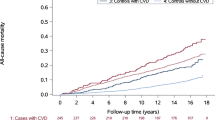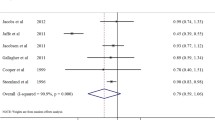Abstract
The objective of this study was to examine mortality differentials among men and women by parity for deaths from cardio-vascular disease (CVD), cancer and other causes. The census-based Israel Longitudinal Mortality Study II (1995–2004) was used to identify 71,733 married men and 62,822 married women (45–89 years). During the 9-year follow-up period, 19,347 deaths were reported. Cox proportional hazard models adjusted for age, origin, and social class were used. A non-linear association between parity and CVD mortality was detected for men and women. Excess CVD mortality risks were observed among middle-aged women with no children (hazard ratio [HR] 2.43, 95% confidence interval [CI] 1.49, 3.96) and among middle-aged women and men with 8+ children (HRwomen 1.64, CI 1.02, 2.65; HRmen 1.40, CI 1.01, 1.93) compared to those with two children. No clear pattern of association between cancer mortality and parity was apparent for men. Elderly women with 8+ children showed reduced mortality risks from reproductive cancers (HR 0.22, CI 0.05, 0.91). Similar parity-related mortality patterns were observed for men and women for deaths from CVD and other causes indicating biosocial pathways. The association between parity and cancer mortality differed by gender, age and type of cancer.



Similar content being viewed by others
References
Kobrin, F. E., & Hendershot, G. (1977). Do family ties reduce mortality? Evidence from the United States 1966–68. Journal of Marriage and the Family, 39, 737–745.
Green, A., Beral, V., & Moser, K. (1988). Mortality in women in relation to their childbearing history. BMJ, 297(6645), 391–395.
Kvale, G., Heuch, I., & Nilssen, S. (1994). Parity in relation to mortality and cancer incidence: A prospective study of Norwegian women. International Journal of Epidemiology, 23, 691–699.
Manor, O., Eisenbach, Z., Israeli, A., & Friedlander, Y. (2000). Mortality differentials among women: The Israel Longitudinal Mortality Study. Social Science and Medicine, 51, 1175–1188.
Ness, R. B., Harris, T., Cobb, J., Flegal, K. M., Kelsey, J. L., Balanger, A., et al. (1993). Number of pregnancies and the subsequent risk of cardiovascular disease. New England Journal of Medicine, 328, 1528–1533.
Jaffe, D., Neumark, Y., Eisenbach, Z., & Manor, O. (2009). Parity-related mortality: Shape of association among middle-aged and elderly men and women. European Journal of Epidemiology, 24, 9–16.
Dekker, J. M., & Schouten, E. G. (1993). Number of pregnancies and risk of cardiovascular disease. New England Journal of Medicine, 329, 1893–1894.
Kotler, P., & Wingard, D. L. (1989). The effect of occupational, marital and parental roles on mortality: The Alameda County Study. American Journal of Public Health, 79, 607–612.
Kravdal, O. (2003). Children, family and cancer survival in Norway. International Journal of Cancer, 105, 261–266.
Grundy, E., & Kravdal, O. (2008). Reproductive history and mortality in late middle age among Norwegian men and women. American Journal of Epidemiology, 167, 271–279.
Rostgaard, K., Wohlfahrt, J., Andersen, P. K., Hjalgrim, H., Frisch, M., Westergaard, T., et al. (2003). Does pregnancy induce the shedding of premalignant ovarian cells? Epidemiology, 14, 168–173.
Kroman, N., Wohlfahrt, J., Andersen, K. W., Mouridsen, H. T., Westergaard, T., & Melbye, M. (1998). Parity, age at first childbirth and the prognosis of primary breast cancer. British Journal of Cancer, 78, 1529–1533.
Butt, S., Borgquist, S., Garne, J. P., Landberg, G., Tengrup, I., Olsson, A., et al. (2009). Parity in relation to survival following breast cancer. European Journal of Surgical Oncology, 35, 702–708.
Navarro Silvera, S. A., Miller, A. B., & Rohan, T. E. (2005). Hormonal and reproductive factors and pancreatic cancer risk: A prospective cohort study. Pancreas, 30, 369–374.
Grundy, E., & Tomassini, C. (2005). Fertility history and health in later life: A record linkage study in England and Wales. Social Science and Medicine, 61, 217–228.
Kravdal, O. (1995). Is the relationship between childbearing and cancer incidence due to biology or lifestyle? Examples of the importance of using data on men. International Journal of Epidemiology, 24, 477–484.
Ross, C. E., & Mirowsky, J. (2002). Family relationships, social support and subjective life expectancy. Journal of Health and Social Behavior, 43, 469–489.
Hammer, M., Gutwirth, L., & Phillips, S. L. (1982). Parenthood and social networks. A preliminary view. Social Science and Medicine, 16, 2091–2100.
Macintyre, S. (1992). The effects of family position and status on health. Social Science and Medicine, 35, 453–464.
Kravdal, O., & Hansen, S. (1993). Hodgkin’s disease: The protective effect of childbearing. International Journal of Cancer, 55, 909–914.
Zhang, Z., & Hayward, M. D. (2001). Childlessness and the psychological well-being of older persons. Journals of Gerontology. Series B, Psychological Science and Social Science, 56, S311–S320.
Kiecolt-Glaser, J. K., & Newton, T. L. (2001). Marriage and health: His and hers. Psychological Bulletin, 127, 472–503.
Wyke, S., & Ford, G. (1992). Competing explanations for associations between marital status and health. Social Science and Medicine, 34, 523–532.
Hinkula, M., Kauppila, A., Nayha, S., & Pukkala, E. (2006). Cause-specific mortality of grand multiparous women in Finland. American Journal of Epidemiology, 163, 367–373.
Kravdal, O., & Hansen, S. (1996). The importance of childbearing for Hodgkin’s disease: New evidence from incidence and mortality models. International Journal of Epidemiology, 25, 737–743.
Hoyer, G., & Lund, E. (1993). Suicide among women related to number of children in marriage. Archives of General Psychiatry, 50, 134–137.
Jacobsen, B. K., Vollset, S. E., & Kvale, G. (1995). Do reproductive factors influence colorectal cancer survival? Journal of Clinical Epidemiology, 48, 1119–1122.
Feldman, C., Eisenbach, Z., & Manor, O. (2003). Mortality differentials by education. Jerusalem, Israel: Israel Central Bureau of Statistics.
Jaffe, D., Neumark, Y., Eisenbach, Z., & Manor, O. (2008). Educational inequalities in mortality: Changes over time in a dynamic population. Health & Place, 14, 287–298.
Shuval, J., & Anson, O. (2001). Social structure and health in Israel. Jerusalem, Israel: Magnes Press.
ICBS. (2002). Statistical abstract of Israel, 2001. Jerusalem, Israel: Israel Central Bureau of Statistics.
Salameh, S., Hochner-Celnikier, D., Chajek-Shaul, T., Manor, O., & Bursztyn, M. (2008). Ethnic gap in coronary artery disease: Comparison of the extent, severity, and risk factors in Arab and Jewish middle-aged women. Journal of the Cardiometabolic Syndrome, 3, 26–29.
Duncan, G. J., Daly, M. C., McDonough, P., & Williams, D. R. (2002). Optimal Indicators of Socioeconomic Status for Health Research. American Journal of Public Health, 92, 1151–1157.
Stover, J., & Ross, J. (2009). How increased contraceptive use has reduced maternal mortality. Maternal and Child Health Journal, doi 10.1007/s10995-009-0505-y.
Lawlor, D. A., Emberson, J. R., Ebrahim, S., Whincup, P. H., Wannamethee, S. G., Walker, M., et al. (2003). Is the association between parity and coronary heart disease due to biological effects of pregnancy or adverse lifestyle risk factors associated with child-rearing? Findings from the British Women’s Heart and Health Study and the British Regional Heart Study. Circulation, 107, 1260–1264.
Sattar, N., & Greer, I. A. (2002). Pregnancy complications and maternal cardiovascular risk: Opportunities for intervention and screening? BMJ, 325, 157–160.
Kritz, S., Barrett-Connor, E., & Friedlander, N. J. (1997). Parenthood and lipid and lipoprotein levels in older men. Annals of Epidemiology, 7, 275–279.
Bernstein, L., Pike, M. C., Ross, R. K., Judd, H. L., Brown, J. B., & Henderson, B. E. (1985). Estrogen and sex hormone-binding globulin levels in nulliparous and parous women. Journal of the National Cancer Institute, 74, 741–745.
Abramson, J. H., Pridan, H., Sacks, M. I., Avitzour, M., & Peritz, E. (1978). A case-control study of Hodgkin’s disease in Israel. Journal of the National Cancer Institute, 61, 307–314.
Lund, E. (1990). Number of children and death from hormone-dependent cancers. International Journal of Cancer, 46, 998–1000.
Koifman, S., & Jorge Koifman, R. (2001). Breast cancer mortality among Ashkenazi Jewish women in Sao Paulo and Porto Alegre, Brazil. Breast Cancer Research, 3, 270–275.
Jaffe, D. H., Eisenbach, Z., Neumark, Y. D., & Manor, O. (2005). Does living in a religiously affiliated neighborhood lower mortality? Annals of Epidemiology, 15, 804–810.
Acknowledgments
Data were created by grant 93-00015/2 from the US–Israel Bi-national Science Foundation and grant 03/120 from the Israel National Institute for Health Policy and Health Services Research.
Author information
Authors and Affiliations
Corresponding author
Rights and permissions
About this article
Cite this article
Jaffe, D.H., Eisenbach, Z. & Manor, O. The Effect of Parity on Cause-Specific Mortality Among Married Men and Women. Matern Child Health J 15, 376–385 (2011). https://doi.org/10.1007/s10995-010-0591-x
Published:
Issue Date:
DOI: https://doi.org/10.1007/s10995-010-0591-x




